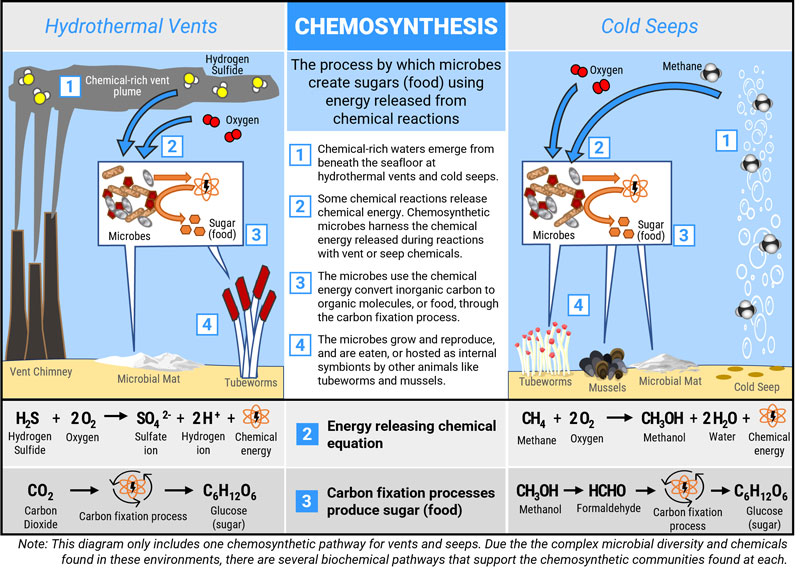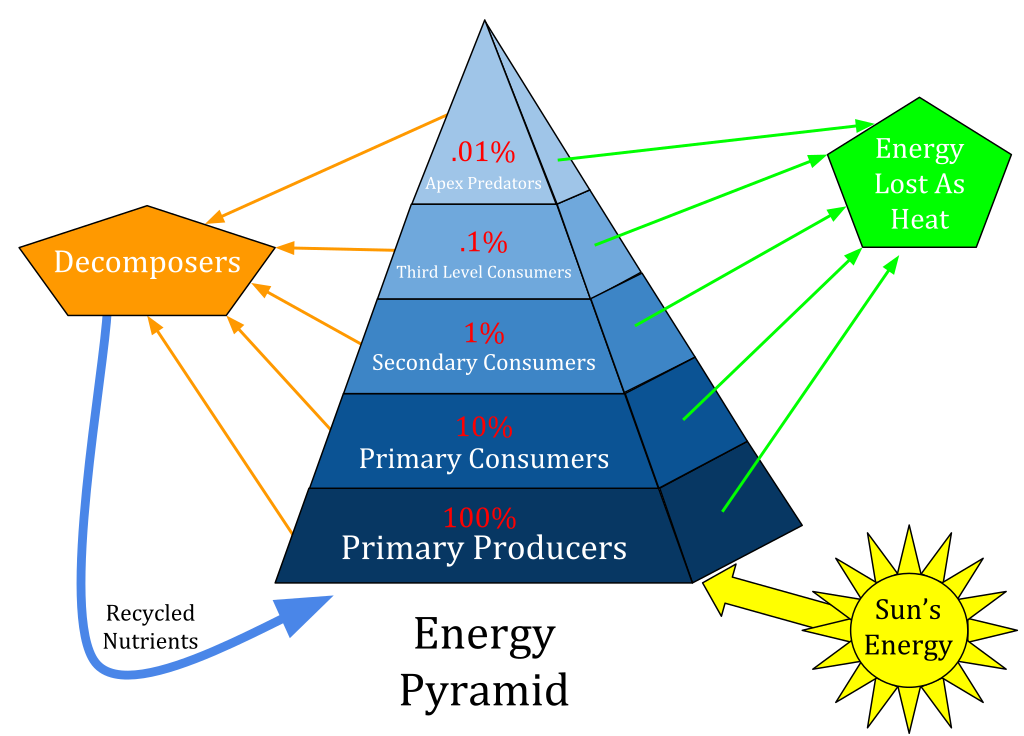Trophic interactions are essential components of ecosystems, delineating the flow of energy and nutrients among various organisms. These interactions, involving producers, consumers, and decomposers, are pivotal in maintaining ecological balance and biodiversity.
Producers
Producers, or autotrophs, are the foundation of ecosystems. They harness energy from the environment and convert it into usable forms, initiating the energy flow in ecosystems.
Photosynthesis
Process: Producers, primarily plants and algae, utilise light energy to convert carbon dioxide and water into glucose and oxygen. This transformation is a cornerstone of life on Earth, driving ecosystems and shaping the atmosphere.
Equation: The chemical equation, 6CO<sub>2</sub> + 6H<sub>2</sub>O + light energy → C<sub>6</sub>H<sub>12</sub>O<sub>6</sub> + 6O<sub>2</sub>, encapsulates this energy conversion.

The overall photosynthesis equation summarises how producers convert carbon dioxide and water into glucose and oxygen using light energy. This underpins energy entry into most ecosystems via autotrophs. Source.
Importance: Beyond energy provision, photosynthesis replenishes atmospheric oxygen and serves as the primary source of organic compounds for most life forms.
Chemosynthesis
Process: In ecosystems devoid of sunlight, like deep-sea hydrothermal vents, certain bacteria execute chemosynthesis. They extract energy from inorganic chemicals to produce organic compounds.
Example: Hydrogen sulphide serves as an energy source for bacteria residing near hydrothermal vents, supporting unique, isolated ecosystems.

The chemosynthesis diagram shows microbes using hydrogen sulphide and oxygen to power carbon fixation, forming organic molecules that underpin vent food webs. This exemplifies primary production without sunlight in deep-sea ecosystems. (Includes a simplified intermediate step not required by the syllabus.) Source.
Consumers
Consumers, or heterotrophs, are organisms reliant on others for nourishment. They extract energy and nutrients by consuming other organisms.
Primary Consumers
Herbivores: These are animals that feed exclusively on plant material. They have specialised digestive systems to extract nutrients from plants, converting these into energy that becomes available to other trophic levels.
Examples: Grazing animals like deer, small organisms like insects, and aquatic species like certain fish exemplify primary consumers.
Secondary Consumers
Carnivores and Omnivores: These organisms prey on primary consumers. Carnivores are meat-eaters, while omnivores consume both plants and animals.
Predation: Through predation, secondary consumers regulate primary consumer populations, preventing overgrazing and promoting biodiversity.
Tertiary Consumers
Apex Predators: These are top-tier predators with no natural enemies within their ecosystems. They play a critical role in controlling the populations of other consumers, maintaining ecological balance.
Examples: Lions in savannahs, eagles in skies, and sharks in oceans are instances of tertiary consumers.
Decomposers
Decomposers are nature’s recyclers. They break down dead organisms and organic wastes, returning nutrients to the environment and completing the energy cycle.
Process of Decomposition
Organisms Involved: Bacteria and fungi are principal decomposers, alongside certain animal species that contribute to the breakdown of organic materials.
Nutrient Recycling: Decomposers convert complex organic substances into simpler molecules, facilitating nutrient absorption by producers and promoting soil fertility.
Energy Release
Metabolic Activities: Decomposers extract energy for their metabolic activities during decomposition, releasing the residual energy into the environment.
Ecosystem Support: By recycling nutrients and energy, decomposers support the sustainability of ecosystems, underpinning biodiversity and productivity.
Energy Pyramids
Energy pyramids illustrate the energy distribution across different trophic levels, offering insights into the energy flow and trophic interactions within ecosystems.

This diagram depicts an energy pyramid with producers at the base and consumers above them, illustrating the sharp decline in usable energy at higher trophic levels. The pyramid shape reflects metabolic losses (often summarised by the ~10% transfer rule) and explains why top predators are few. Source.
Structure of Energy Pyramids
Base: Producers form the base, possessing the highest energy content, derived from photosynthesis or chemosynthesis.
Middle Layers: Occupied by primary and secondary consumers, each successive layer harbours less energy due to metabolic usage and heat loss.
Top Layer: Tertiary consumers reside here, receiving the least energy, which underscores the limited population sizes at higher trophic levels.
Energy Transfer
10% Rule: On average, only 10% of the energy at one level is transferred to the next. Energy loss occurs due to metabolic processes and heat dissipation.
Implications: This energy diminution explains the pyramid shape, with broad bases of abundant producers and narrow tops of few tertiary consumers.
Ecological Efficiency
Measurement: Ecological efficiency quantifies energy transfers between trophic levels, influenced by factors like metabolic rates and heat loss.
Variability: Different ecosystems and organisms exhibit varied efficiencies, impacting the structure and dynamics of ecological communities.
Implications of Trophic Interactions
Biodiversity
Variety of Life: Trophic interactions contribute to the complexity and diversity of life within ecosystems. Each level and interaction adds layers of ecological complexity.
Health of Ecosystem: A diverse array of interactions often signifies a robust, resilient ecosystem capable of withstanding environmental perturbations.
Human Impact
Resource Consumption: Human activities, especially resource extraction and land use changes, profoundly impact trophic interactions, often leading to imbalances and biodiversity loss.
Climate Change: Anthropogenic climate change alters trophic interactions, affecting species distributions, behaviours, and interspecies relationships.
Conservation Efforts
Sustainable Practices: Conservation initiatives often focus on restoring and preserving balanced trophic interactions to enhance ecosystem resilience and biodiversity.
Restoration: Ecological restoration aims to re-establish healthy trophic interactions, often necessitating interventions like reintroducing keystone species or controlling invasive species.
These detailed insights into trophic interactions offer students a comprehensive understanding of the intricate, interdependent relationships that weave the tapestry of life within ecosystems. Each organism, from the energy-capturing producers to the recycling decomposers, plays a pivotal role, underscoring the interconnectedness of all life forms and the imperative of conservation efforts.
FAQ
Energy pyramids can vary markedly between different types of ecosystems due to variations in energy input, transfer efficiency, and species interactions. In marine ecosystems, for instance, the energy pyramid can sometimes appear inverted with primary consumers having more biomass than producers due to the rapid reproduction rate of phytoplankton. In contrast, terrestrial ecosystems typically feature the classic pyramid shape with a broad base of producers. The energy transfer efficiency, species’ metabolic rates, and environmental conditions also influence the shape and structure of energy pyramids, leading to ecosystem-specific variations that reflect the underlying trophic interactions and energy dynamics.
Decomposers play a pivotal role in energy flow beyond breaking down dead organic matter. They facilitate the release of stored energy in dead organisms and organic waste, making it available to other organisms within the ecosystem. This energy release supports the metabolic activities of decomposers and other microorganisms involved in the decomposition process. Moreover, decomposers help in recycling nutrients, which enhances the nutrient availability for producers, indirectly influencing the energy capture and storage at the base of the trophic levels. Thus, decomposers are integral in both energy and nutrient cycling, underpinning ecosystem productivity and sustainability.
Human activities profoundly impact energy flow and trophic interactions within ecosystems. Industrialisation, agriculture, deforestation, and urbanisation alter the natural habitats and resources available to organisms at all trophic levels. Pollution and climate change, resulting from anthropogenic activities, can disrupt the physiological processes of organisms, including photosynthesis in plants, impacting energy capture and storage. Overfishing and hunting affect the population sizes of specific trophic levels, leading to imbalances in energy flow and ecosystem dynamics. Such disruptions can lead to cascading effects throughout ecosystems, affecting biodiversity, resilience, and the overall health of the environment.
Tertiary consumers are fewer in number in ecosystems due to the energy loss that occurs at each preceding trophic level. As energy flows from producers to primary and then to secondary consumers, a significant portion is lost at each stage due to metabolic processes and as heat, as per the 10% energy transfer rule. Consequently, there is less energy available to support tertiary consumers, leading to their reduced numbers. This energy constraint impacts the population size, distribution, and diversity of tertiary consumers, and it underscores the pyramid shape of energy pyramids, with a broad base of producers and a narrow top of apex predators.
The 10% energy transfer rule significantly influences both the structure and functioning of ecosystems. It implies that at each successive trophic level, only about 10% of the energy is passed on, while the rest is lost primarily as heat. This energy loss constrains the number of trophic levels in an ecosystem, as there is insufficient energy to support a large number of levels. Consequently, it also affects the population sizes at each level, with fewer organisms at higher trophic levels. This energy limitation impacts the biodiversity, complexity, and resilience of ecosystems, shaping their dynamics and interactions.
Practice Questions
Producers, such as plants and algae, are foundational in ecosystems, converting solar energy into chemical energy through photosynthesis, creating organic compounds and oxygen. Consumers, including herbivores, carnivores, and omnivores, obtain energy by consuming other organisms, transferring energy up the trophic levels. Decomposers, like bacteria and fungi, break down dead organisms and waste, recycling nutrients back into the ecosystem and making them available for producers. Energy transfer is typically inefficient, with approximately 90% lost as heat at each trophic level, a concept depicted in energy pyramids.
An energy pyramid illustrates the energy distribution across different trophic levels in an ecosystem. The base comprises producers with the highest energy content, derived from processes like photosynthesis. As we move up the pyramid, energy decreases due to metabolic activities and heat loss, leading to fewer organisms at higher trophic levels. Primary consumers occupy the next level, followed by secondary and tertiary consumers, each with diminishing energy content. This pyramid structure underscores the energy loss at each level, explaining the reduced population sizes and energy content at higher trophic levels.

